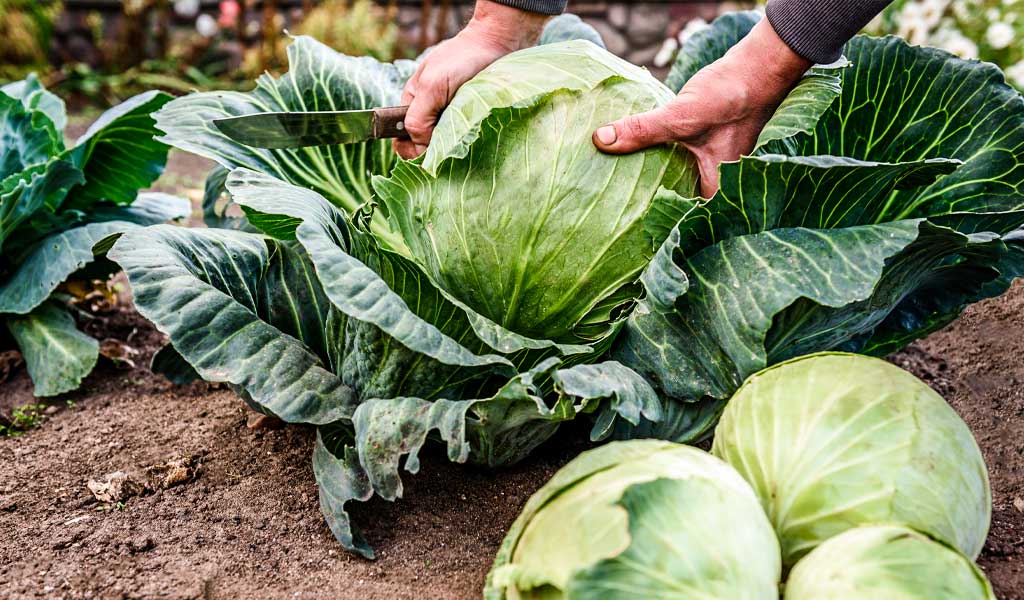Cabbage is a kitchen garden and allotment staple with many varieties to choose from - Spring and Summer types, Savoys, Red Cabbage and some outstanding heritage varieties which represent those old favourites which have stood the test of time in many gardens.
Where To Grow
Cabbages do best in a sunny spot with moist, alkaline soil that has had plenty of well-rotted organic matter, such as garden compost, added. If you think your soil may be acidic then do a pH test and add lime to the soil if necessary.
Cabbages are heavy feeders so make sure to rotate your planting and avoid growing them in the same spot year after year as the soil will become very depleted.
Although not traditionally container grown, cabbages one or two in a large, deep planter would do well.
Sowing & Planting
Cabbages can be sown outside either directly in the ground or in modular trays.
If you have limited space, it’s easiest to sow in trays once seed per cell and transplant outdoors later. This avoids taking up a lot of room early in the season, and allows you to use the bed for fast-maturing crops such as lettuces.
If you have plenty of space sow straight into a prepared bed at 30 - 45 cm apart - check individual seed packets as some varieties will need a slightly different spacing.
Sowing Calendar For Cabbages
- Summer cabbages: sow from late February/early March (under cloches or similar cover) until early May; transplant in May/June
- Winter cabbages: sow in April/May; transplant in late June/July
- Spring cabbages: sow in July/August; transplant in September/October
Before sowing make sure the soil is firm - as with all brassicas Cabbages need anchoring solidly.
Make a drill 1 cm deep and sow seeds thinly along it - cover and water well.
If you are growing in a nursery bed you can transplant your young cabbage plants when they have five or six well developed leaves.
-
Water them well in advance
-
Plant with the lowest leaves at ground level
-
‘Puddle’ in the plants with plenty of water
Aftercare
Keep cabbages watered in dry spells - a thorough soaking every 10 days is better than a little each day. When the heads begin to form water more frequently to increase the size of the head.
Apply a general purpose or high nitrogen feed during the summer to top up nutrients and encourage leafy growth.
Keep on top of weeding but take care if using a Speed Hoe as cabbages are shallow rooted.
Harvesting & Storage
Harvest once they have reached the desired size and formed a firm head - Cut through the stem just above ground level with a sharp knife.
If you cut a 1 cm deep cross in the stump of spring and summer cabbages after harvesting, they should go on to produce a second smaller cabbage!
Rough Guide to Harvesting Cabbages:
- Spring Cabbages - April/May
- Summer varieties - August/September
- Autumn varieties - September/ October
- Red cabbage - August/ October
- Savoys and Winter Cabbage – November/February
Pests & Diseases
Cabbage Whites (large white and small white butterflies) are the main concern.
Cover growing crops securely with fine insect proof mesh, rather than fleece which will get too hot, throughout the growing season and remove caterpillars regularly by hand or using organic pesticide.
Small slugs can work their way into the heart of developing cabbages and perforate them - slug traps filled with beer are a traditional and successful way to reduce the problem.
In Winter deter pigeons by covering with net or mesh - a birdscare or even scarecrow can also help!
Cabbage Root Fly lays its eggs at the base of the stem and the larvae eat the roots causing the plant to wilt and eventually die - small collars are available which can be slotted around the base of each cabbage stem to prevent egg laying and crop protection netting held over the plants on a crop cage also helps.




